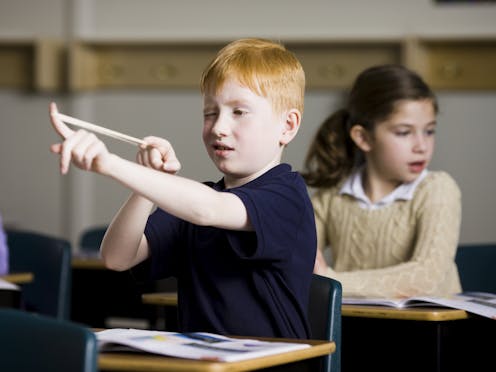Disruptive kindergartners are likely to be bullied later in elementary school
Children who are bullied in school are at higher risk for depression and anxiety later in life.

Kindergartners who act out, disrupt classrooms, get angry and argue with their teachers are especially likely to be bullied once they reach third, fourth and fifth grade, our research group has found.
We continue to investigate bullying in U.S. elementary schools, but our initial findings indicate that the odds that disruptive kindergartners will be shoved, pushed or hit, teased or called names, left out, and have lies told about them are roughly twice as high as for kindergartners who do not act out in classrooms. We observed this in analyses accounting for many other risk factors.
Our findings are consistent with, but also extend, prior research documenting that children who are from poor families or who are struggling academically are more likely to be bullied than their peers who are from wealthier families or who are more academically skilled.
As with older children, we find that young boys are more likely to be shoved, pushed or hit, while young girls are more likely to be teased or called names, left out, and told lies about. Children with disabilities, particularly boys, are more likely to be frequently bullied. Black boys more frequently experienced other children telling lies about them than white boys, consistent with prior work finding that Black children are at greater risk of being bullied in adolescence.
We believe our study represents the first analysis of a nationally representative sample that identifies which kindergartners are most likely to be bullied later in U.S. elementary schools. We hope the information helps parents and school staff identify and support young children who are especially likely to be bullied.
The harms of bullying
Schoolchildren who are frequently bullied are likely to later be depressed, anxious and suicidal as well as to be unemployed, impoverished and abusing substances. These risks are as large as those associated with being placed in foster care or experiencing maltreatment.
Early identification can help support those children who are being bullied and so limit the potential damage. Screening and prevention efforts are more effective when delivered while children are still young. Mental health supports may be needed for those being frequently bullied.
And looking at specific types of bullying may help schools and parents more directly serve the different psychological needs of children experiencing physical or nonphysical bullying.
The results suggest that the more schools can do to help kindergartners learn to manage their disruptive behaviors, the less likely these children are to be bullied later on in elementary school.
[Interested in science headlines but not politics? Or just politics or religion? The Conversation has newsletters to suit your interests.]
Paul L. Morgan has received funding from the National Institute of Child Health and Human Development and the U.S. Department of Education's Institute of Education Sciences.
Read These Next
A Colorado guaranteed income program could help families, but the costs are high
A few hundred extra dollars a month would go a long way for many Coloradans.
Polytechnic universities focus on practical, career-oriented skills, offering an alternative to trad
Polytechnic universities try to incorporate skills-based learning into education.
The Ivies can weather the Trump administration’s research cuts – it’s the nation’s public universiti
While headlines focus on Harvard and Columbia, state universities train far more STEM students, power…






